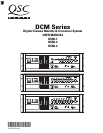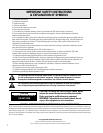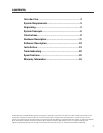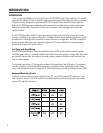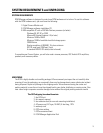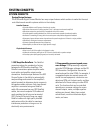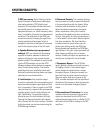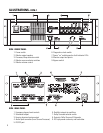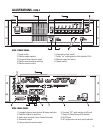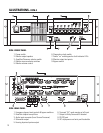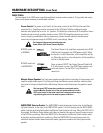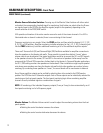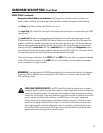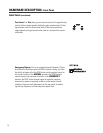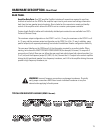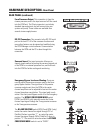
7
6. Password Security: The crossover settings
that you create can make a dramatic difference
in the sound quality within the theater. Many
installers pride themselves on being able to
adjust the electrical parameters (crossover
points, equalization, delay, etc) to exactly
compliment the speaker and room interactions.
As such, their ability to set these parameters is
a “value added” service which deserves protec-
tion from competitors. We have therefore
included a security system where you can
protect your settings within the DCM from
being uploaded and copied by the DCM Man-
ager software. Only your unique password will
allow viewing or editing of the crossover
settings. Should you forget your password, an
entirely new configuration can be loaded.
7. Emergency Bypass: If the DCM fails,
quickly getting a usable sound path is as easy
as flipping a switch. A front panel bypass
switch provides the projectionist a simple
Emergency Bypass. A passive crossover has
been built into the center channel routing so
that even with a total loss of power to the
DCM, a usable sound path will be maintained.
Activation of this bypass is done by the projec-
tionist via a front panel Emergency Bypass
switch.
8. Surround Insert Connections: To accom-
modate multichannel surround, the surround
signals can be routed from the DCM to an
external processor box (such as a Dolby SA-10)
and back into the DCM for routing to the QSC
amplifiers.
SYSTEM CONCEPTS
3. DSP processing: Digital filtering of audio
signals is known to have several advantages
over analog solutions. DSP (digital signal
processor) IC chips allow extremely accurate
and reliable control of frequency and time
adjustments (boost, cut, cutoff frequency, delay
time), and stability (immunity from temperature
variations). The audio path of the DCM uses
conversion circuitry (changing the signal from
analog to digital and back again) which is
designed to minimize all background noise and
react to the dynamic range of any film track.
4. Speaker Database (pre-programmed
settings): QSC has worked with the leading
suppliers of theater speakers to obtain the
optimum settings for most common theater
speaker models. This database is easily loaded
into the DCM hardware unit and the DCM
Manager software offers features to organize,
store, and edit these settings. This feature
guarantees that your installation starts with
technically optimized settings before you begin
adjusting for room characteristics.
5. Fault Analysis: Each amplifier output
channel is compared to the corresponding input
signal providing complete signal path confirma-
tion. For example, if there is signal at the DCM
input but there is no signal at the corresponding
amplifier output, then the fault indicator will
light. Additionally, if an amplifier output is
shorted or open, the fault indicator will light.
Pressing the Diagnostics button will indicate
which channel has this fault condition. Detailed
fault information can also be viewed using the
DCM Manager software.



